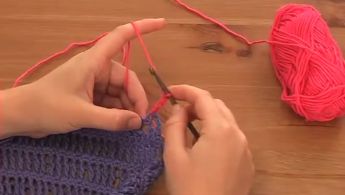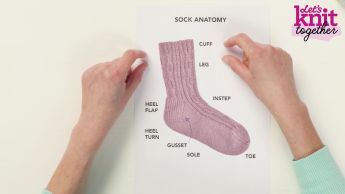How to: do arm knitting
video by
Let's Knit Together
- Overview
- Practical Guides
It’s knitting – but not as you know it! Using amazing mega chunky yarn, and your arms as the needles, you could make a statement scarf in half an hour. All you need is plenty of the right type of yarn and your arms.
As with regular knitting, relative diameters of your arms and your yarn, and how tightly you tension the yarn on your arms, is just like regular knitting. A fine yarn and big needles will produce a more happy finished fabric. As a guide, the yarn in the video is using a 200g ball with a meterage of just under 15.5m; by contrast 200g of chunky aran can contain 250m of yarn. Search for arm knitting yarn online to see what is available. Here, we explain how to cast on, create a stocking stitch by simply working from one arm to another, and cast off. This will have V knit stitches on the front and U purl bumps on the back. TIP Roving is a term used to describe a bundle of long untwisted fibres, unlike yarn that has been spun to twist the fibres together into a narrower strand. Long tail cast on Start by gauging how much yarn you need for a long tail cast on: wrap the tail end around your arm loosely by the number of stitches you need, then add another couple of wraps to be on the safe side. Make a slip knot to give you the long tail needed and place the loop on your right arm. To work the cast on, hold the yarn strands in the sling shot position by grabbing both strands in your left hand and inserting your thumb and index finger between strands just under the knot. The tail end should be over your thumb at the front and the working yarn over your finger at the back, with the stands held in the other fingers. To cast on a stitch, enlarge the loop on the left thumb by inserting the finger and thumb from your right hand under the strand, then pick up the working yarn running over the index finger and pull through to make a loop and slip over your right hand and onto your arm. Tighten the stitch. Repeat to cast on the required number of stitches. To work stocking stitch, you will hold the working yarn in the hand of the arm that the stitches are being transferred from, and use your other hand to pull the stitches over and create new loops, that after turning, you’ll then slip over the other hand. To work a row from the right to left arm With the stitches on your right arm, pick up working yarn in your right hand. Use your left hand to pull the first stitch off your right arm to create a loop, and place it on your left hand, turning the loop as you put it onto your arm. Pull on the working yarn to tension the stitch on your left arm. Repeat until all of the stitches have been transferred to the left arm, keeping an even tension. To work a row from the right to left arm With the stitches on your left arm, pick up working yarn in your left hand. Use your right hand to pull the first stitch off your left arm to create a loop, and place it on your left hand, turning the loop as you put it onto your arm. Pull on the working yarn to tension the stitch on your right arm. Repeat until all of the stitches have been transferred to the right arm, keeping an even tension. Casting off Plan to cast off with the stitches on your left arm, as you would usually do for a knit row. Work two stitches from left to right, as described above, then use your left hand to lift the first stitch on your right arm over the second stitch and over your right hand at the same time. Work another stitch, then repeat. Carry on until all of the stitches have been cast off. Cut the yarn leaving a tail for weaving in and pull this through the last loop to fasten off.









































